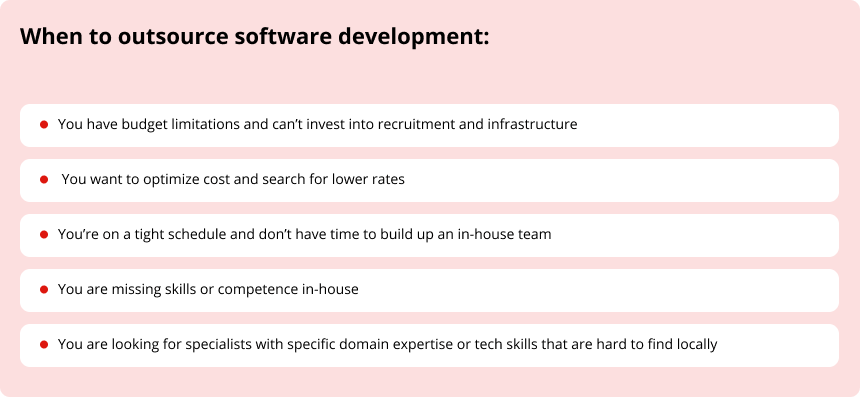How to Outsource Web Application Development without Losing Quality
Three events created the insane demand for outsourcing web development in the last couple of years.
- Web presence became a must for every brand, B2B and B2C alike. Since 2020, even small-niche companies that thought they could sit it out realized that their survival depends on if and how they can connect with their audience online.
- The world learned how to work remotely. And nailed it. Today, even the most skeptical companies that had doubts and fears about outsourcing from a remote provider changed their mind. It went all the way from “I don’t know about that” to “this might work.”
- And finally, the tech talent market developed a gap the size of the San Andreas fault which is constantly growing. There are currently 40 million unfilled tech positions that will leap to 80 million by 2030 if things go on this way. For many companies, big and small, outsourced web development turned out to be the only way to put together a decent software team at a reasonable cost.
If you consider outsourcing your web project or already leverage this strategy but want to squeeze more, this post will come in handy. We will talk about the key models of outsourcing, give you an all-purpose plan for the first steps, and provide a few tips on how to select the right software outsourcing partner and hire a reliable offshore or nearshore software development team.
But before we begin, let’s make sure we are on the same page and there’s no confusion between common outsourcing terms we will use in the post.
IT outsourcing is a general term. It refers to delegating the whole or a part of an IT project to an outside service provider (software house, tech company, design agency, individual contractor, etc.) instead of assigning it to an in-house team. Web development outsourcing then refers to – you guessed it – outsourcing web projects (web app development, website redesign, SaaS and web platform development and support, etc.).
Depending on what and how you outsource, you can choose between product development, dedicated team or outstaffing, or a combination of each approach. For example, consider all the staff augmentation pros and cons to see if this model works for you.
Product development
Product development implies assigning your vendor the whole project, from soup to nuts. It’s ideal for companies that have no previous experience in software development or no in-house resources to lead and manage the project. Your vendor may take off with as little as a raw idea and turn it into a market-ready product. Consider this option if you need to outsource the entire web application development project.
Dedicated team
Dedicated team is a popular approach to fill in the tech talent gap, speed up the delivery, and reduce development costs. It implies setting up a dev team that is employed by your vendor but works exclusively on your project, usually on a long-term basis. The team often consists of cross-functional specialists (BA, designers, developers, Scrum master, QA, DevOps), and there’s someone who oversees the project on your end (product owner, project manager).
So if you were to outsource web app development using this approach, you would ask your vendor to set up a team and could kick off within weeks. Because it normally takes less time for a vendor to find and pick the right specialists than if you would hire web development team from zero.
Outstaffing
A. k. a. IT team augmentation, staff augmentation, or team extension, this is a fast and easy way to boost the effort of your in-house team by hiring remote specialists from a service provider. Remote specialists weave into your routine and work as an integral part of your team while being employed by your vendor. This way, you avoid recruiting hassle, employment and infrastructure expenses, and at the same time gain flexibility and slash development costs.
Example: In 2021, a UK-based data analytics company needed to augment their tech team to pick up the pace all the while keeping development costs under control. This was the first software outsourcing experience for the company, so they were looking for a service provider with a proven track record and resources to quickly up their game. We qualified 3 senior engineers (full-stack, DevOps, QA automation) thus allowing the client to split their dev team into two. As the result, the client doubled development speed at a cost 2x lower compared to hiring senior engineers for these roles in-house. Read the full success story…

There are also three location-based models you can use to outsource web development: onshore, offshore, and nearshore development services. We will briefly outline the difference between the three. But if you need a more detailed review of each model, check our guides on how to hire a nearshore web development team and offshore web development team.
- Onshoring: Outsource from a vendor located in your country (e.g., a New York agency augments tech team with engineers from a Tuscon-based service provider).
- Nearshoring: Outsource from a vendor located in a neighboring country within the same time zone or in close proximity (e.g., a Norwegian company outsources software projects to a Polish tech company).
- Offshoring: Outsource from a vendor that can be located anywhere outside your time zone, often on a different continent (e.g., a US company leverages the benefits of dedicated teams located in the Czech Republic).
Now that you have an idea about the most common web development outsource models, let’s move straight to what you can (and WILL) get from using this strategy.
Scale your team faster with Digiteum
Put an end to months of unsuccessful search for qualified engineers. Contact our team to get a consultation on your outsourcing needs.
Get a consultationShort answer: because modern web applications are complex interactive web systems that require a decent budget and a skilled team to build and support.
- Team. To design and build a web app, you will need several cross-functional specialists. The simplest web development team structure consists of a business analyst, project manager, solution architect, UX/UI designer, software engineers (frontend, backend, full-stack), QA, and often DevOps.
- Scalability. Modern web apps are built with scalability in mind and may require rapidly increasing resources and extended infrastructure.
- Architecture and tech stack. Depending on the stack and the type of web application architecture you will work with, you need to access diverse expertise (microservices, cloud, containers, etc.) and skills (Angular, React.js, .NET, Java, Python, etc.).
Take all that and add the growing shortage of tech talent. Now you can see why outsourcing web app development is a viable strategy. It allows you to:
Hire faster, deliver first
Outsourcing will help you solve the biggest and quite expensive challenge – hiring skilled engineers and being able to scale fast when needed. Reputable vendors usually have a large database of prequalified IT specialists and can staff a project within weeks (compared to months of recruiting in-house). So you can save money and time on recruiting, deliver faster and gain the upper hand in your market.

Build more, pay less
Outsource web application development to cut web app development costs due to the difference in rates. Without compromising the quality, of course. For instance, average hourly rates for hiring senior engineers in Central and Eastern Europe are twice lower ($53-$76) than the rates for the same-level talent in North America ($114-$170). Depending on your goal, you can use outsourcing to either cut down on your expenses or hire more people without stretching your budget. Or do both.
Bet on quality, trust experts
When you trust your web project to a reputable tech company, you get more than muscle. You can tap into years of tech and business expertise and diverse domain knowledge. As a result, you get a time-tested development process and effective communication practices, which eventually lead to timely delivery and a high-quality end product.
The advantages of web application development outsourcing don’t end here. In our experience, you will be able to reap the combination of benefits (time, cost, effort, quality, flexibility). All you need is to have the right process in place and find a reliable partner.
Let’s talk about how to outsource web app development without risks and with maximum gain.

Step 1. What do you have? Bring it together.
What are your requirements, delivery timeline, resources, limitations, short-term and long-term goals? What do you expect from your vendor? What are your reasons for outsourcing in the first place? Answering these and other project-related questions will help you understand what services you are looking for. And will become a starting point for your conversation with vendors.
You may have only a back-of-the-napkin sketch of your idea right now. But you will need more than that to talk to potential service providers and get an estimate. If your primary interest is outstaffing, you need to have a list of the skills and qualifications you are looking for. Ideally, put together an RFP (request for proposal) that describes project goals, high-level requirements, timeline, scope of work, and budget.
Step 2. Choose location and collaboration model
Using all the information you gathered in the first step, you can choose a collaboration model and start reviewing preferable locations. Study the size of the talent market, legal and business infrastructure, economic stability, data protection laws in the locations you consider for outsourcing web application development. It’s essential to evaluate possible barriers that you may have to deal with (language, time zone).
Step 3. Select and review vendors
At this point, you already narrowed down your choice to one or several locations and can start looking for reputable vendors. Here are a few things to pay close attention to when reviewing potential tech partners:
- Company history and track record
- Steady market standing and growth
- Validated testimonials, references, and portfolio
- Relevant case studies and domain expertise
- Tech stack and engineering practices
- Team composition and seniority level
- Employee and client retention rate
- Solid security and data protection practices
- Well-defined process and communication framework
We will talk more about choosing a reliable partner in the next section, so stay with us.
Step 4. Work on your contract
You have chosen a vendor and are ready to get down to work. But before you do, you need to negotiate and sign an agreement. We have a CEO guide for negotiating an IT contract (that’s right, we have a guide for every case) you can use to start with. Or scroll through this quick wrap-up of the most essential tips:
- Discuss key terms in detail before getting the paperwork ready. It will save you a lot of time.
- Put together a negotiation team or consult with someone who knows the details of the project and understands the software development process, not only the legal context.
- Make sure the contract includes a reasonably detailed description of key project aspects: scope, team composition, budget, payment terms, development methodology, project roadmap, milestones and deadlines, change requests, requirements management, and acceptance criteria.
- Pay special attention to confidentiality, security, and data protection clauses: IP rights, data security, NDA, conflict resolution, and acceptance criteria.
- Review service guarantee and support and maintenance clause to avoid misunderstanding after project delivery.
Step 5. Kick off with a smaller project
This is a general recommendation for any high-cost service. Starting with a milestone or a small project (Discovery Project, web design outsourcing, IT consulting) is a good way to validate your choice before getting into a long-term commitment.
In the previous part, we mentioned a few things to look into when reviewing outsourcing specialists. Check these must-have characteristics that will help you find a trustworthy partner and spot red flags.
Proven track record and verifiable references
Case studies, testimonials and about us page are perhaps the first things you will go through when reviewing services providers. Check Clutch, GoogFirms, Crunchbase, or other large company data providers to verify and validate your findings. Aside from real customer stories, you can dig up a lot of valuable information about the vendor’s service focus and strengths, domain expertise, and even average rates.
Client and employee retention and in-house competence
High retention rate is always a good sign. It means that you are dealing with a mature service provider with a focus on long-term collaboration and resources to support clients for years. If you plan to outsource web app development on a project-based model, make sure your vendor also has the necessary competence and can cover the full-cycle of web app development services, from analysis to development to support.
Communication framework
Poor communication is one of the top reasons for outsourcing failures. So when reviewing potential vendors, try to find out how they describe their process and guarantee transparent communication. Your provider should be able to set up a clear and convenient communication framework that will be effective and suit everyone.
Flexibility
Flexibility is a valuable trait that can help you gain a strong competitive advantage. Ask your vendors how they manage changing requirements. How do they respond to market feedback? Can they quickly adjust to new requirements and scale up the team? Answers to these questions will help you understand if partnering with a particular service provider will give you the business agility you need to win the market.

Use outsourcing to hire exceptional engineers faster and without draining your budget dry. We will help you find an effective approach to fulfill your pressing needs, whether you need to scale your tech team as soon as possible or build one from scratch.
During over 14 years in the IT market, we helped dozens of clients from Europe, North America, and Australia create quality products and reach even the most ambitious delivery goals:
- Put together a dedicated team of 15+ engineers to develop and deliver a cloud-based solution for precision medicine within only 8 months. Read the full story…
- Scaled up the backend team of a travel tech company and added 9 senior .NET engineers to speed up the development and migration of a large microservices-based SaaS. Read the full story…
- Set up a full-stack team of 20+ engineers, designers, and managers for outsourced web app development for a leading US photo lab. Read the full story…
Start your project
Contact our team to get an expert consultation or schedule a discovery call for your project.
Let's talkQuick round-up
- Growing demand for web development and increasing talent shortage make outsourcing one of the primary strategies for cost-effective web app development.
- There are several outsourcing approaches and location-based models that fit different business needs.
- Having a time-proven process and communication practices in place is essential for successful web app outsourcing.







